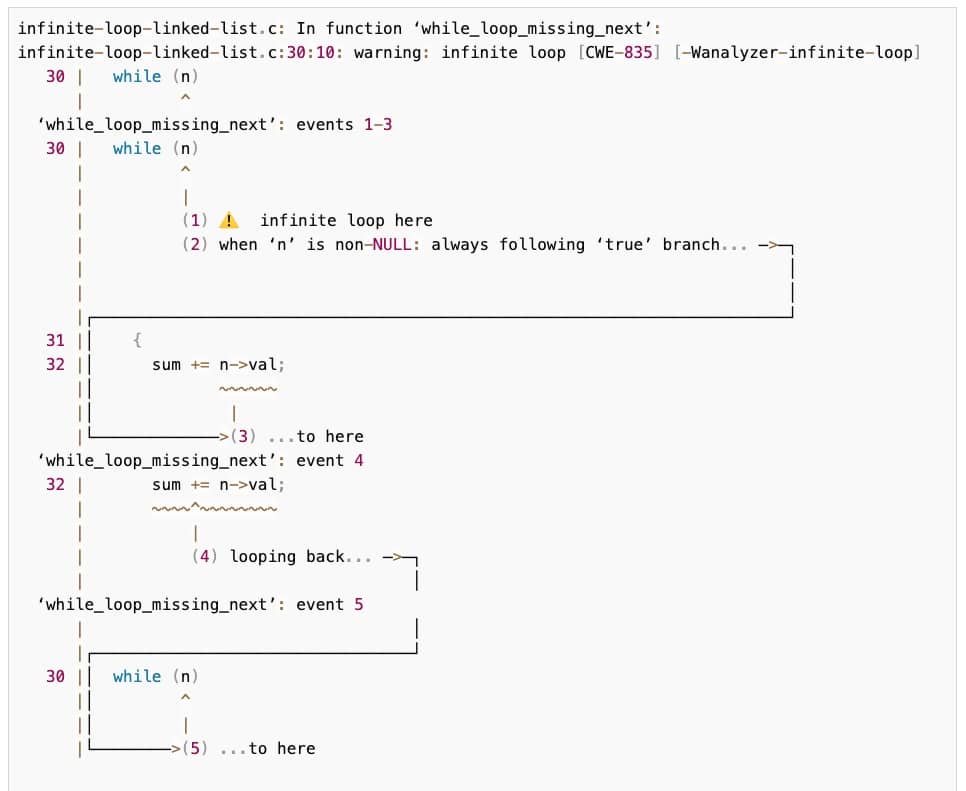The upcoming release of GCC 15, developed by Red Hat’s compiler team, marks a significant leap in making C and C++ development more accessible, especially when debugging and analyzing complex code. With an emphasis on clarity and developer experience, GCC 15 introduces six key enhancements aimed at reducing frustration and improving productivity.
1. Cleaner Execution Path Visuals
GCC’s static analyzer, introduced in GCC 10, now features improved visualizations of predicted code execution paths. These include:
- ASCII-style control flow diagrams
- Warning emojis (⚠️) to highlight critical events
- Improved clarity of event chains, especially in infinite loop and undefined pointer behavior scenarios
This enhancement helps developers quickly understand how and why a particular issue arises, reducing the guesswork often associated with low-level bugs.
2. Friendlier C++ Template Error Messages
C++ template errors are notoriously verbose and hard to follow. GCC 15 introduces an experimental nested error format, enabled with:
-fdiagnostics-set-output=text:experimental-nesting=yesCode language: JavaScript (javascript)This indentation-based format presents a structured and readable hierarchy of failed template substitutions, clearly showing:
- The number of candidate overloads
- Why each candidate failed
- Where constraints were not satisfied
This change transforms long walls of text into a clean, understandable tree of reasoning—an immense help for debugging template-heavy code.

3. Machine-Readable Diagnostics via SARIF + Replay Tool
GCC 15 expands support for SARIF (Static Analysis Results Interchange Format). New features include:
- Simultaneous SARIF and text output, using the new
-fdiagnostics-add-output=sarifoption - Improved SARIF content, capturing multiple source locations, include-chains, and labeled ranges
- A new tool:
sarif-replay, which can simulate how the errors would appear in classic GCC format, including source code context and fix-it hints
This makes it easier for IDEs and CI pipelines to process compiler output for visualization, reporting, or automated auditing.
4. Smoother Transition to the C23 Standard
GCC 15 now defaults to -std=gnu23 (C23 plus GNU extensions), replacing gnu17. To ease the migration:
- Diagnostics about C23-specific keywords (e.g.,
bool,true,false) are now clear and contextual - Function declaration mismatches now indicate the expected and actual parameter signatures
- Typedef redefinitions and pointer assignment issues are labeled explicitly with location-aware notes
These improvements help legacy codebases adopt modern standards more confidently.
5. Updated Color Scheme for Errors and Warnings
GCC 15 introduces a more thoughtful use of color-coded diagnostics to emphasize type mismatches, control flow errors, and invalid operations.
For example, conflicting types in an invalid + operation will now be shown in distinct colors (e.g., green vs. blue) across source highlights and messages. This visual differentiation makes it easier to spot issues at a glance—especially in large codebases.
6. libgdiagnostics: Diagnostic Features as a Shared Library
Previously exclusive to GCC internals, the new libgdiagnostics library allows external tools to access:
- Colorization and syntax highlighting
- Fix-it hints
- Source range labeling
- SARIF output generation
Available in C, C++ and Python bindings, this enables easier integration into IDEs, linters, and static analysis tools, allowing more developers to benefit from GCC’s powerful diagnostic engine.
Try It Today
GCC 15 is currently available as a pre-release in Fedora 42 Beta, with general availability expected later this month as GCC 15.1. You can also explore it online through Compiler Explorer.
Whether you’re dealing with complex C++ templates or need better analysis tools for large codebases, GCC 15 offers a smarter, more human-centric development experience—without sacrificing performance or reliability.
Via: Redhat

